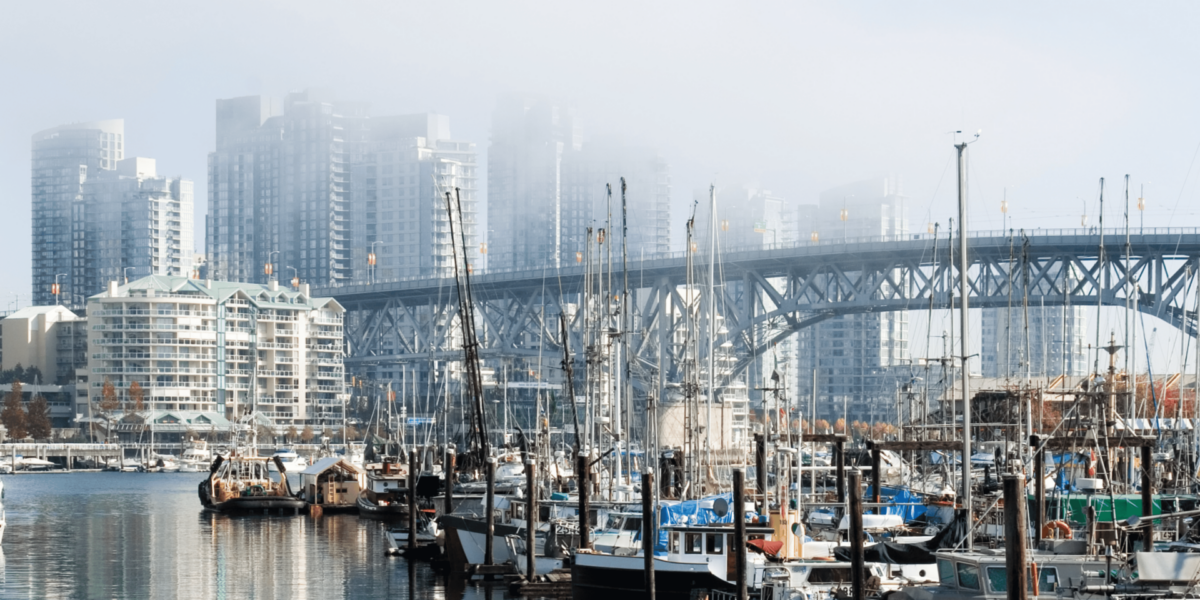Vancouver’s Mood Is Defined by Its Natural Elements
Coastal Vancouver creates a cityscape that shifts with the weather. Fog rolls in from the water, softening the edges of buildings. Light filters through clouds and reflects off glass towers. Together, these elements shape how the city looks, feels, and moves throughout the day.
Residents wake to streets covered in mist. The skyline fades behind a curtain of gray, not hidden but hushed. These changes affect more than just visibility — they influence mood, energy, and how people interact with the city around them.
Fog Reshapes the Urban Experience
Fog arrives often and without warning. It doesn’t just fill the air; it alters the city’s rhythm. Traffic slows, sounds mute, and landmarks disappear into the mist. These shifts create a quiet urgency. People adjust their movements, stay closer to the ground, and rely on familiar routes.
In this setting, the city becomes more internal. A person walking through Yaletown on a foggy morning may notice smaller details—lights in apartment windows, the texture of pavement, or the glow of taillights. The skyline no longer pulls attention upward. Instead, it invites reflection.
Natural Light Transforms Vancouver Hour by Hour
Light in Vancouver works in layers. The city rarely experiences direct sunlight without interruption. Clouds scatter brightness across the sky. In clear moments, glass buildings catch the sun and flash briefly before fading into shadow. These light shifts repeat all day, often several times in an hour.
The changing light affects the appearance of streets, structures, and public spaces. During early morning, towers along Coal Harbour glow with silver tones. By mid-afternoon, the same buildings take on blue and gray hues. These transitions aren’t decorative — they reshape how people see and move through the city.
The Skyline Responds to Coastal Conditions
Vancouver’s skyline reflects more than architecture. It reacts to its coastal environment. On clear days, mountains stand behind the towers in sharp relief. When fog descends, the city becomes a layered silhouette. Buildings lose their edges. Movement slows.
This responsiveness isn’t accidental. Developers design structures with large glass panels, allowing buildings to absorb and reflect their surroundings. The skyline adapts, showing different versions of itself depending on the season, the weather, and the time of day. These shifts give the city a dynamic visual identity.
Weather Influences Behavior and Public Space Use
Coastal weather patterns in Vancouver influence how people use the city. Light rain or heavy fog often changes where people go and how long they stay outside. Planners consider this in the design of transit shelters, walkways, and public plazas.
Imagine walking along the seawall as fog moves in from the bay. The mist changes your pace. You may choose a sheltered path or pause beneath a canopy instead of continuing toward the open shore. These small decisions reflect how deeply the weather and city layout work together to guide behavior.
Moodscapes Create a Living Connection Between People and Place
A moodscape forms when environmental elements shift how people feel in a space. In Vancouver, fog and filtered light combine with water, glass, and stone to shape those emotional layers. The city doesn’t maintain a static image. It moves between sharp and soft, light and shadow.
This constant change builds awareness. Commuters on the SkyTrain might notice how downtown looks different than it did the day before. A cyclist crossing the Burrard Bridge sees the skyline half-shrouded in clouds, and that image lingers. These moments create a lasting connection between place and perception.
Color Tones Shape Urban Identity
Vancouver’s moodscapes depend heavily on color. The dominant palette includes slate gray, sea blue, forest green, and steel silver. These tones appear in both the natural and built environments. Together, they establish a consistent visual identity that feels grounded in the city’s geography.
Glass towers reflect the sky’s changing tones, while concrete structures pick up hints of nearby foliage. This cohesion between color and form strengthens the sense of place. Vancouver looks and feels like itself—no matter how often the light changes.
Urban Design Integrates With the Coastal Environment
Vancouver’s design decisions support its coastal climate. Narrow streets channel wind, while wide sidewalks give people space to navigate in low visibility. Building height restrictions near the waterfront maintain open views, allowing residents to connect with the horizon even during dense fog.
These choices support functionality and livability. Public benches often sit beneath partial covers. Outdoor lighting includes warm hues to contrast with the cool tones of misty days. These details encourage people to engage with the city even when conditions seem harsh.
The City’s Rhythm Follows Weather Patterns
Life in Vancouver moves to the pace of its weather. Clear days bring higher foot traffic. Foggy mornings slow transit lines and increase indoor activity. Local businesses adapt by shifting hours or rearranging window displays to take advantage of diffused natural light.
People match their routines to the sky. A runner might leave earlier to catch the morning break in cloud cover. Office workers adjust blinds throughout the day as sunlight moves across their buildings. These daily habits demonstrate how light and fog do more than shape a view — they guide a way of life.
Photography Captures the City’s Emotional Range
Photographers often turn to Vancouver’s moodscapes to document emotion, movement, and change. The city offers rich material — buildings disappearing into fog, wet pavement reflecting street lamps, or clouds sitting low over harbor cranes.
Capturing these scenes requires patience and timing. The right moment may last only seconds before the light shifts or the fog lifts. But when caught, these images tell the deeper story of the city: not just what it looks like, but how it feels to live inside it.

